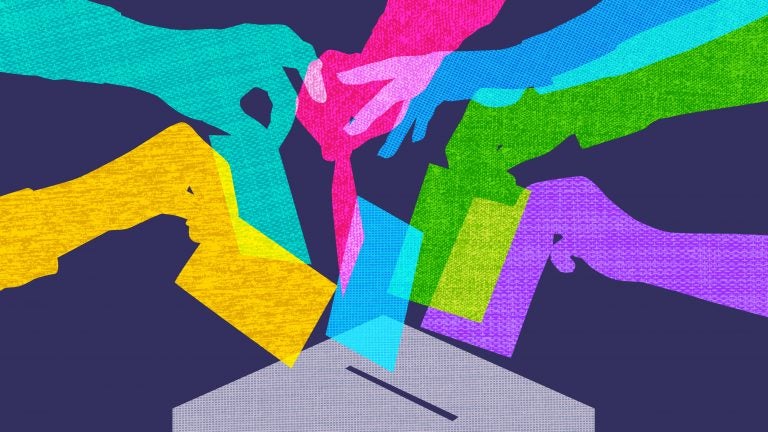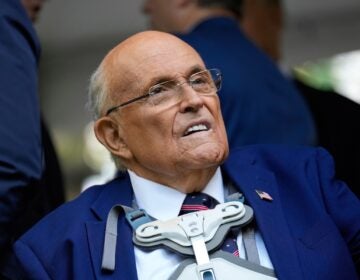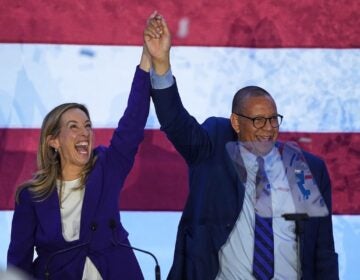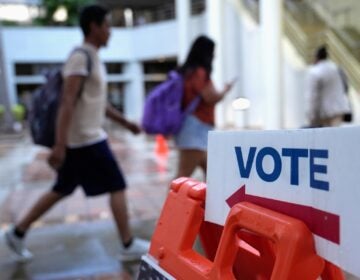On the sidelines of democracy: Exploring why so many Americans don’t vote

Colourful overlapping silhouettes of hands voting in fabric texture. (smartboy10/Getty Images)
Just in the past few months, elections in the U.S. have been decided by hundreds of votes.
The 2016 presidential election tilted to Donald Trump with fewer than 80,000 votes across three states, with a dramatic impact on the country. Yet, only about 6 in 10 eligible voters cast ballots in 2016.

Credit: Miles Watkins/NPR
Among the other 4 in 10 who did not vote was Megan Davis. The 31-year-old massage therapist in Rhode Island never votes, and she’s proud of her record.
“I feel like my voice doesn’t matter,” she said on a recent evening at a park in East Providence, R.I. “People who suck still are in office, so it doesn’t make a difference.”
Davis might sound contrarian, but she’s not. Although these days more Americans say they’re enthusiastic about voting in a midterm election than at any point in the last two decades, come Election Day, nonvoters like Davis will still probably be the norm. For every 10 adults eligible to vote, only about four cast a ballot in the 2010 and 2014 midterm elections.
You have to go back to the turn of the 20th century to find a midterm election when a solid majority of people voted (of course, back then, the right to vote was far more limited, so the eligible voting pool was smaller, more male and more white).
Every election cycle there’s a lot of attention on who voted and why. But there’s another important question: Who is not voting — and what impact does that have?
The wealthy tend to vote more frequently. Nonvoters are more likely to be poor, young, Hispanic or Asian-American. Some research also indicates they’re more likely to align with the Democratic Party.
It’s debatable whether election results would be different if the entire population voted, but voting determines more than which candidate wins or loses. It ultimately influences which policies elected officials enact and whose interests candidates ignore and acknowledge.
“The one consistent finding from 1972 up through 2008 and in subsequent elections are that voters and nonvoters have different preferences on economic policies,” said Jan Leighley, co-author with Jonathan Nagler of the book Who Votes Now? Demographics, Issues, Inequality, and Turnout in the United States.
Her research found that nonvoters are more likely, for example, to support a redistribution of wealth, housing bailouts and expanded social safety net programs.
Hundreds of thousands of nonvoters want to vote, but can’t.
In 2016, 4 percent of registered voters did not vote because of “registration problems,” according to a Pew Research Center analysis of Census Bureau data. Many would-be voters face a range of barriers: voter ID laws, registration difficulty or criminal records. An estimated 10 percent of adults in Florida, for example, can’t vote because of a felony conviction.
Some people who want to vote but can’t have been removed from the voting rolls. Across the country, the rate at which people are being purged from the voting rolls, a process historically intended to keep records updated, has increased substantially compared to a decade ago, according to a report from the Brennan Center published this summer. The analysis found 4 million more people were purged between 2014 and 2016 than in the equivalent period between 2006 and 2008.
Legal obstacles are an important part of the nonvoter story, but there are many millions of Americans who can vote and yet choose not to. Their reasons are vast: Some are apathetic or too busy. Others don’t like their choices, they don’t think their vote matters, they think the system is corrupt, or they don’t think they know enough to vote.
NPR traveled to four states where different factors affect why people aren’t voting at high levels — age, income, education level, and habits.
Las Vegas: The young and disengaged
Shelby Mabis, a stocky blonde Marine corps veteran, remembers taking a government class in high school, but said he didn’t learn anything about voting.
“From what all I know about voting is you show up to a poll place and you vote, but I don’t know what I need to bring. I don’t even know what happens during there,” said Mabis, 23, outside of his mandatory political science class at a community college in North Las Vegas. And so he’s never voted before.
Mabis is not unusual. There’s a high density of people in his area who don’t vote, as in many places.
“Whenever young people are surveyed, there is a significant lack of knowledge about how exactly the government works, and, therefore, how their vote actually matters,” said Kei Kawashima-Ginsberg, the director of CIRCLE, an initiative at Tufts University that studies youth civic and political participation. She recently conducted a survey of working-class youth and found that nearly 20 percent of young people said they don’t think they know enough to be able to vote.
Her research has found that a majority of young people don’t think voting is an effective way to change society. They also have major misconceptions about voting. Some think getting a citation for driving under the influence meant they could no longer vote.
But for Mabis, not voting is not just about education — it’s about location.
“Right now, being away from home, I don’t feel connected to the political system here at all,” he said, referring to Nevada. “Since I’m not from here, I really feel like this isn’t my home.”
Mabis grew up in Missouri, and that’s where he registered to vote. But he said it’s not easy to stay connected to Missouri politics.
Analysts say this is common – young people are more often transient and so they often feel less invested in local elections.
Youth turnout nationwide for midterms is around 20 percent. For older adults, it’s closer to 50 percent. When you look at who votes frequently over many years, the numbers look even starker.

In over a dozen interviews, NPR heard similar reasons from young nonvoters for why they don’t participate in politics: they don’t feel their vote matters, they don’t care, they’re busy, or they don’t feel like they know enough to vote.
But in some cases, they’re also particularly eager to choose individual candidates instead of a party label. In 2016, many said they felt uninspired by both Hillary Clinton and Donald Trump.
So, like Jonas Rand, they didn’t vote for president.
“I don’t believe it is actually effective to vote as a main method of accomplishing political change,” said Rand, a senior who studies anthropology at the University of Nevada, Las Vegas.
Rand follows the news closely, he considers himself a political activist, but he’s not a fan of the current two-party political system.
“The system itself is stacked against the citizenry,” he said.
He thinks Trump is a “fascist,” but still he doesn’t see how voting for Clinton would have changed anything, pointing out that Nevada’s votes in the Electoral College went for Clinton anyhow.
But if young people don’t vote, they’re less likely to be targeted by political campaigns. And that worries community activist Francisco Morales.
“It’s no coincidence that politicians care a lot about Medicare and Social Security. Seniors vote all the time,” said Morales, state director for the Center for Community Change Action.
But, he says, issues that millennials care about, such as student debt, are often overlooked “because politicians are not afraid of our voting bloc.”
West Virginia: The class divide

(Andrea Bruce for NPR)
McDowell County, W.Va., is the county with the lowest voter turnout in a state that had one of the lowest turnout rates in the country in 2016.
In Welch, W.Va., the county seat, median household income hovers around $25,000 a year. Sixty one percent of registered voters in McDowell County are nonvoters, people who have voted zero or one time in the last eight elections, according to a review of data from L2, a nonpartisan voter file vendor.
Tammy Lester, a 42-year-old fast food worker in McDowell County, W.Va., can’t remember the last time she voted.
“We vote these people in and they don’t help McDowell County,” she said, as she walked along the deserted streets in the rundown downtown with her daughter. “There’s nothing … there’s no jobs when our kids graduate, they have to leave.”
Beyond a movie theater, a small pharmacy, and a couple of county offices, most of the storefronts are closed. A couple of years ago, the closest Walmart shut down, and now there’s hardly anywhere locals can buy fresh produce.
Lester said politicians always ignore her county. “We are last on everything,” she said.
“What good does it do, though, when they’ll promise you anything and then it’s a lie,” she asked rhetorically.
Lester, like many nonvoters, never went to college. She stopped going to school in eighth grade. Research has shown the biggest and most persistent difference between who votes and who doesn’t is education and economics. Class is a more accurate predictor of voting behavior than race, ethnicity, gender or any other demographic factor, according to Jan Leighley. Leighley writes in her book Who Votes Now? that nearly 80 percent of high-income earners vote, compared to barely 50 percent of low-income Americans.
“I just don’t think my vote matters,” said Josh Mullins, as he pushed a stroller along the street in McDowell County.
The last time Mullins, a 33-year-old unemployed former restaurant worker, remembers voting was in 2004 for Democratic presidential nominee John Kerry. Nowadays, he sees no point, saying the system overrules what people want.
“Hillary [Clinton] won the popular vote and we still have Trump for president,” he said. “To me it says … it was just the [Electoral College] that put Trump in office.” Voters in each state determined the Electoral College outcome.
Another major reason people say they don’t vote is the time and effort taken away from other priorities.
“They’re working several jobs, they’re low-income, they’re low-education, they’re younger and they decide the costs are too high for them,” explained Michael McDonald, a political scientist at the University of Florida who tracks turnout at the U.S. Elections Project. “They decide they’ve got a lot of other things going on in their lives.”

(Credit: Alyson Hurt/NPR)
El Paso, Texas: Low Latino turnout
At the Bowie Bakery, a popular institution in El Paso’s Segundo Barrio, or second ward, Christina Rodriguez examined the glass cases filled with Mexican sweet breads, tres leches cakes, cupcakes, cookies and pastries. She ordered a batch of cookies for her 15-year-old’s quniciniera and made her way to the door.
Rodriguez, a 38-year-old single, working mom, is always on the go. It’s why, she says, she doesn’t vote.
“I don’t even know who’s running,'” she said, laughing with a bit of embarrassment. “I should look into it, but, honestly, I haven’t given it more than a thought.”


(Andrea Bruce for NPR)
She doesn’t have time, she said, to look up the candidates, research their platforms and head to the polls.
“I’d rather not show up and do an uneducated guess,” she said. “I don’t want to make a mistake.”
Growing up, her parents never voted either. Voting, she said, wasn’t part of the culture in this border city where over 80 percent of residents identify as Latino.
“Voting is often taught and it may take a couple generations to become a habit,” said Lisa Wise, the elections administrator in El Paso.
Some immigrant families are still unfamiliar with voting. Experts suggest this might also explain why Asian-American voter participation is low, despite high education levels. The adult Asian-American population is largely still foreign-born.
“I do what I do to make my life better,” said Rodriguez. “I don’t depend on (politicians) to change things for me.”
But analysts say low Latino turnout in Texas isn’t occurring in a vacuum. Texas has long been home to one of the worst voter turnout rates in the country; 51.6 percent of Texans voted in 2016.
Research has shown that competition energizes the electorate, and Texas is largely not seen as a competitive state, particularly in presidential years. Locals say they have a joke in El Paso that the only time a major presidential candidate passes through the city is when he’s driving to New Mexico.
“Texas has not had the swing state machine that we’ve seen in other places around the country,” said Mindy Romero, director of the California Civic Engagement Project at the USC Sol Price School of Public Policy. “There aren’t those resources, money, and investment coming into the state to get every voter.” This is also an issue in California, the state with the largest Latino population.
Broad political apathy seeps into local and statewide elections, too. At the Bowie Bakery in El Paso, most customers didn’t know that their native son, Beto O’Rourke, is running in a closely watched Senate race against Republican incumbent Ted Cruz. They didn’t know that if O’Rourke wins he would be the first Democratic senator elected from Texas in a quarter century.
It also doesn’t help engage voters that El Paso has had a history of corrupt elected officials.
Texas is undoubtedly one of the highest nonvoting states in the country, but poor Latino turnout goes far beyond the borders of Texas.

More than half of eligible Latinos nationally don’t vote. In the last presidential election, Latinos represented 12 percent of eligible voters nationwide, but only 9 percent of the overall electorate on Election Day.
Many analysts predicted that Donald Trump’s offensive rhetoric about Latinos would mobilize records numbers of Latino voters in 2016, but turnout remained relatively even with 2012.
“You may be upset about somebody like Donald Trump and what you’re hearing,” said Romero. “But if you don’t see how or why … politicians and the political landscape matters for you … you don’t think you have agency,”
Romero points to two main reasons so many Latinos are nonvoters: the disconnect they feel with the political process and the anemic investment in outreach.
But Romero doesn’t blame the Latino community, she and Leighley both point out that candidates rarely try to reach new voters.
“This idyllic notion that campaigns are out there to get everyone to vote is simply not true,” said Leighley. “They need one more vote than their opponent, they will go to people based on those voter files that they know have voted before and they focus on them.”
It’s more expensive and time-consuming to chase down infrequent voters.
—
Methodology
NPR used data from L2, a nonpartisan voter file vendor, to analyze and illustrate what differentiates nonvoters from frequent nonvoters. Because our data set is derived from a voter file, it’s limited to registered nonvoters, as opposed to unregistered nonvoters. We defined a “nonvoter” as someone who voted in zero or one of the last eight elections, and a “frequent voter” as someone who voted in six, seven or eight of the last eight elections. Those eight elections includes both primary and general elections, which means the data goes back to approximately 2010 nationwide, varying slightly in some states like those with off-year elections. So, if someone voted one time in the last eight years, perhaps for Barack Obama in 2008 or Donald Trump in 2016, but did not participate in any other elections, they would be characterized as a “nonvoter.”
9(MDAzMzI1ODY3MDEyMzkzOTE3NjIxNDg3MQ001))




